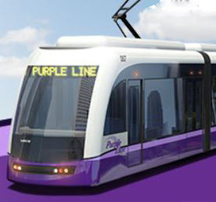Specific Changes Needed in BRT Plan
And Transportation & Environment Committee
Action Committee for Transit appreciated testifying about the Countywide Transit Corridors Functional Master Plan before the Council. As the T&E committee starts its work sessions, we hope it will consider the following ideas. With respect to your question about converting “mixed” treatments to “repurposed” treatments, please see Item #4. Examples include (but are not limited to) University Boulevard between Route 29 and Langley Park (p. 54); New Hampshire Avenue between Route 29 and Randolph Road (p. 45).
1) Remove language concerning “traffic analysis” from the plan. Instead, state that “Corridors with the greatest degree of traffic congestion will be given the highest priority for construction of BRT.” State further that roads with dedicated bus lanes will be considered to satisfy local-area traffic tests if the bus lane is not congested, and bus speeds will be measured on the bus lane for purposes of area-wide traffic tests.
2) Add an explicit statement about the scope of the master plan. Relocation of bus stops, retiming of traffic lights, repurposing of roadway space for bicycles and buses, and traffic calming generally should not require a master plan amendment.
3) Eliminate reversible median bus lanes. The reversible median lane will be confusing for transit riders because buses in each direction (am or pm peak) will alternate between using the median and the curb lane throughout the day.
4) No roadway that carries a BRT line should be wider than six lanes, including bus lanes. On roads that now have six or more lanes, BRT lanes should be created only by repurposing and not by road widening.
5) Narrow existing rights-of-way where they exceed what is usable by a six-lane road with wide sidewalks and bike lanes. BRT corridors will not succeed unless buildings front directly on the sidewalk and are not set back.
6) Create a new category of pedestrian-friendly BRT roads in the “Road Code.” Where possible these should include: medians that separate bus lanes from general traffic, design speeds of 30 mph or less, midblock marked crosswalks when intersection spacing is 800 ft or more, narrow lanes, and wide sidewalks. The corridors should highlight easy access for pedestrians and bicyclists, which could also encourage more street-level activity for businesses near BRT stations.
7) Add a specific right-of-way recommendation for the MARC line corridor as was done for the BRT corridors. Clarksburg and upcounty could make such good use of MARC for commuting, if only it had more capacity.
Sincerely,
Tina Slater, President
Action Committee for Transit

